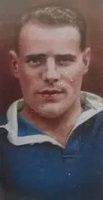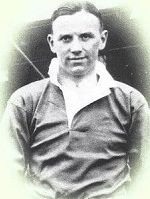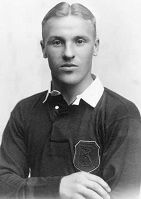1934 - The Ireland-Scotland International
International and club football can experience conflict with both and each wanting access to players' skills and time. What is not said is that there was a point in football's history when such conflict might have led to the impossibility and therefore abandonment of the former. The year was 1931. Moreover, it might have been a direct result of Scotland finally playing against countries other than the Home Nations.
England had first played against a non-British team in 1908. It was a 1-6 away-win in Vienna against Austria, the first of four fixtures on what can only be described as a very successful summer tour of a good part of the Austro-Hungarian Empire. Game two, again in Vienna and against the same opposition, finished 1-11. Game three took the Saxons to Budapest and a 0-7 defeat of Hungary and game four to Prague and a 0-4 win over Bohemia, a selection made and coached by ex-Scottish international, Jake Madden.
And this same sweep through Austria, Hungary and what is now Czechia was repeated in 1909 and might have been expanded but for The Great War, England only resuming in 1921, 1923 and 1924 against Belgium, against France and Sweden in 1923 and in 1924 against France once more. And Ireland, that is the then Irish Free State, Eire as it would become, joined the party for the 1924 Olympics. It played and defeated Bulgaria in the second round. It lost, only after extra time, to The Netherlands in the quarter-finals.
But still there was no movement from Scotland. That would only come in 1929, a result of the election two years earlier of the innovative Robert Campbell of St. Johnstone as President of the Scottish Football Association and be in the form of an early Summer Tour to Norway, Germany and The Netherlands. In fact even that is something of a stretch. The Norwegians and the Dutch still do not regard the fixtures against them as official and perhaps with reason. Of the teams just to have finished in the Scottish League's top six four - Celtic, Hearts, Queen's Park and Partick - did not have representatives in the party, whilst Campbell's St. Johnstone, from ninth, had two including eighteen year old goalkeeper, Alex McLaren.
However, the tour and the trip the following summer to France with a much stronger team seems to have set alarm-bells ringing at English club level, notably at Arsenal. It and others, of course, had Scots under contract, understandably wanted to protect their assets and did so by putting pressure first for international games at least to be relegated to mid-week, which by the end of the 1929-30 season had become non-release of any non-English players. Immediately impacted were Chelsea's Tommy Law, the inestimable Alex Jackson, for whom it was to be indirectly career-ending, and Arsenal's own Alex James. All three were in the Scotland team to have played, if fact lose badly to, England in May 1930, at which point the portcullis came down, on British soil at least.
Thus our October 1930 fixture against Wales saw only Scots-based players selected, as did the February one against Northern Ireland and the one in March versus England, actually a home win. And whilst the same did not apply to the summer tour to Austria, Italy and Switzerland it was replicated against Ireland in September 1931, with the sole exception of James Connor of Sunderland, against Wales in October, England in April 1932, France in May and Ireland again in September. And whilst non-release did not also seem to apply for Ireland, certainly against England, perhaps due to the the timing of the games, it did to Wales. When in 1929 the two had met all but three of the Welsh team were playing in England. In 1932 it would be two of eleven and one of that pair, Ben Ellis, was at Motherwell. Yet in 1930 just one was in England and he, Emrys Ellis, was at Nunhead in London and non-league.
Actually, with Bob Campbell able to negotiate to his eternal credit a return to the previous status-quo and perhaps saving global, international football in the process, to Scotland the non-inclusions of Anglos made little difference to results. The only loss had been to England and away. In fact it was what happened next that is intriguing. For the game against Wales in October 1932, the first after reconciliation, four Anglos were brought in. Scotland was thrashed 2-5 at home, the mixed half-back line having a mare. And, whilst it was followed by a win against England, Campbell's last in charge, that was with just one Anglo, Dally Duncan on the left-wing, and before things began to fall badly apart. Four defeats, to all three home nations, and a draw against Austria followed to November 1934, with inclusion of Anglos, particularly at half-back, apparently still problematic. Scotland for the first time ever finished bottom of the Home-Nation table.
On the face of it it seemed Scots- and English-based had over the eighteen months of non-inclusion of the latter become less able to play together and there is some evidence to support such a possibility. Again Arsenal was now leading the way but this time tactically. There Herbert Chapman, albeit at the suggestion of Diasporan Scot, Charlie Buchan, had permanently introduced the stopper centre-half, effectively 3-2-5 or at best 3-2-2-3. A reversion to the longer ball was a result and Anglos were adapting to it in direct contrast to the Scottish short-passing game still in use North of the Border. It meant some incompatibility. However, it also came at a moment when there was no dominant Scottish centre-half. For most of the decade from 1922 there had been Davie Meiklejohn. At 5 ft 7ins and eleven and a half stone he was never going to be an obvious physical presence but he could pass, tackle and was a tactician like few others. Yet, in 1931, he aged thirty-one, the Rangers' man had been dropped, possibly somewhat prematurely, after which a replacement was sought, several tried with none sticking and much disturbance, manifested in terms of both personnel and performance not just in the centre of the half-back line but amongst the half-backs in general and the full-backs too. It was, for example, in this period that at right-half a certain Matt Busby of Manchester City via Bellshill in 1933 won his one and only cap.



In fact it was not until Rangers itself filled Meiklejohn's shoes from 1933 onward that for Scotland the centre-half situation was resolved. The man to step up was Jimmy Simpson. At about five feet 10ins he was perhaps taller than predecessors and not as good a defender but as a former inside-forward he was the attacking epitome of what was looked for in Scotland rather than England for the position. Thus it was, despite a poor start in October 1934, defeat in the game in question away to Ireland, with Simpson then allowed to grow into the role those around him were also steadied, with the Scots- and Anglo-incompatibility eliminated. In the half-back line he was helped by having fellow Ger, George Brown, to his left with Alex Massie returning from American "soccer" initially to fill the slot on the right. Moreover, when Massie's form wavered a certain Bill Shankly took over seamlessly, joined, albeit for one cap only, by Scott Symon. And at full-back from 1935 Andy Anderson, George Cummings and then Andy Beattie and Jerry Carabine created a solid two from four. Indeed even when Simpson himself began to wane there was again continuity. From Middlesbrough via Edinburgh Bobby Baxter, as the first Anglo for forty years since Cowan but from much the same mould, was there to step up.
Quite simply Simpson and then Baxter as Scottish centre-halves plus Campbell's restoration of full choice of talent were to change a run from 1931 to 1934 of seven wins, five losses and two draws, more or less one to one, to from 1935 to 1939 thirteen wins, four losses and four draws, or more than three to one. That was comparable with the 1920s and who knows what might have been but for the War; perhaps not the decade of disasters that began with the decision on the 1950 World Cup, fatal abandonment in Britain of the Scottish game for the English one and finished with the 9-3 defeat at Wembley in 1961.
(PS: There is one more observation that is worth making not just of the Scottish but for the British game as a whole. The second half of the 1930s was also the period that formed not only two of the greatest, sung managers the English game has known in Busby and most particularly Shankly, but also at club level Shankly's largely unsung bat-man in the Liverpool boot-room, Reuben Bennett, and equally unsung Jimmy Gordon, the third man and, as well as he could be, the glue that for a time held Brian Clough and Peter Taylor together at both Derby and Forest and Clough on his own at the latter. And in Scotland too from it would emerge not just the first, albeit unsuccessful national manager, Beattie, but also feeding Symom back into Rangers as the direct and very successful replacement of Bill Struth.)


